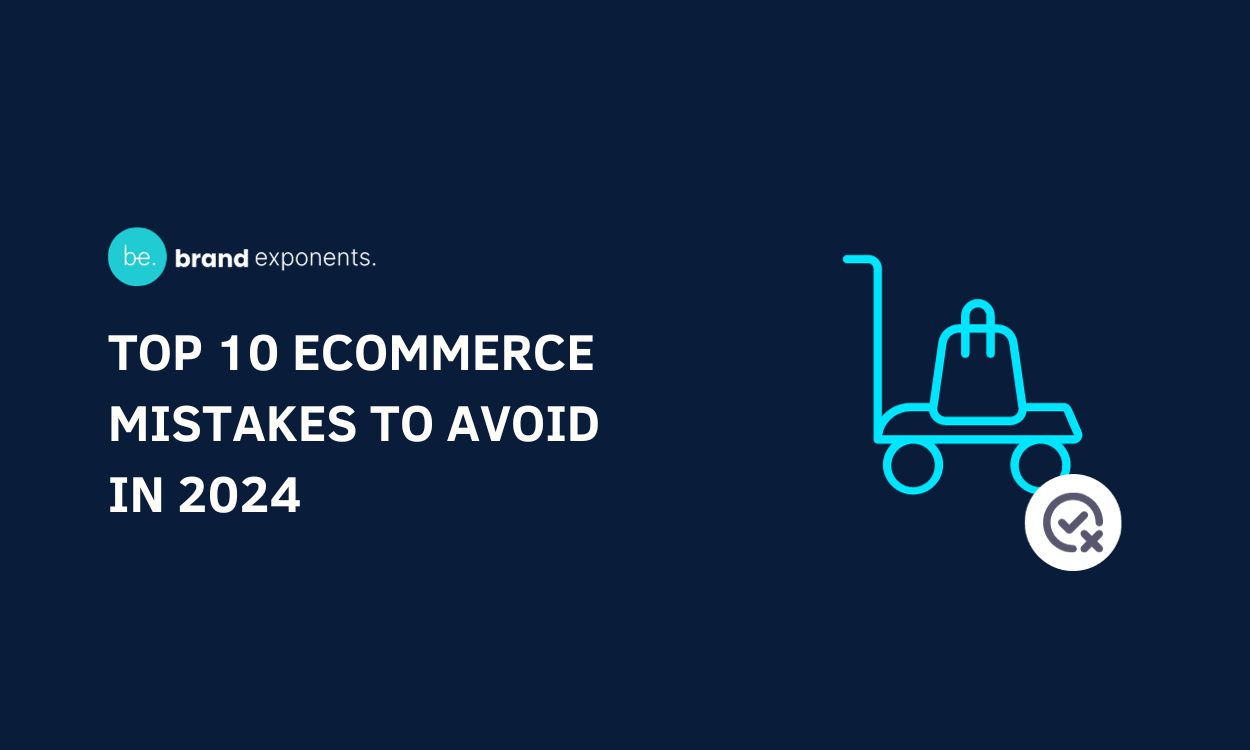Do you want your eCommerce website to be the best? Willing to find out your eCommerce mistakes
From features to layouts to functionalities to ease, you must be considerate in many areas. An eCommerce website that easily navigates customers through the purchase journey has better conversions.
In this article, we will mention the top mistakes you need to avoid.
As an eCommerce store owner, you must know how important it is to prove a seamless process to attract customers and convince them to purchase.
Common eCommerce Mistakes To Avoid
Creating and managing a successful e-commerce store is a year’s journey. You can’t expect to excel the day you make your website live.
While it’s impossible to predict all your mistakes when building and running your eCommerce website, a few common mistakes could be avoided.
Learn from our experience to avoid eCommerce mistakes of your website.
1. Poor Website Design and Navigation
The first thing your potential customer views once they land on your website is its design and how easy it is for them to navigate.
A poorly designed website with cluttered layouts, confusing navigation, and unappealing visuals can discourage users from exploring your products.
A clean and organized design helps users quickly find what they want.
Ensure your website has clear categories, a prominent search bar, and intuitive menus. Consistent branding and a visually pleasing design also contribute to a positive user experience.
You might want a WordPress theme with beautiful navigation and design that fits your website’s niche.
Further, checking if the theme has pre-built categories and tags is essential. Make sure that you avoid this eCommerce mistake.
2. Lack of Clear Product Information
The fear of purchasing online is still huge.
Many claim that they prefer making a physical purchase, given the complexity of purchasing online.
One of the many ways your potential customer feels uninterested in your website is clear information about the product.
Insufficient product information leaves customers with unanswered questions, making them hesitant to purchase.
Include comprehensive and accurate product descriptions, high-quality images from different angles, sizing charts, specifications, and other relevant details.
Further, we suggest adding 2 to 3 images for each product and giving all the important information that adds value to the understanding of the product.
This information helps customers understand what they’re buying and reduces the likelihood of returns due to mismatches with expectations. This way you can avoid this eCommerce mistake.
To add clear product information, you can use various WordPress plugins to beautifully present all the information on your website.
3. Complicated Checkout Process

A checkout page is the last step of the customer purchase journey. You wouldn’t want your potential customer abandoning the cart and leaving your website due to complications in the checkout process.
Many have claimed to stop shopping from the page of the complicated checkout process. Easing the checkout page makes it simpler for your customers to shop from you.
A complex checkout process with too many steps, mandatory account creation, or excessive form fields can frustrate customers and lead to abandoned carts.
Ensure that you’re only asking your potential customer for the necessary information.
Create your checkout page accordingly based on the kind of product you’re selling, i.e., physical or digital.
For example, websites selling digital products will not require the billing address.
We suggest studying the importance of a clear checkout page and how you can easily create one for your website.
Optimize your checkout process by offering guest checkout options, minimizing steps, and providing clear progress indicators. Offer multiple payment options and ensure the process is smooth on desktop and mobile devices. This way you can easily avoid this eCommerce mistake.
Many WordPress themes offer a simple and optimized checkout page that does the job for you. You can use a suitable plugin if your theme has a rather complicated checkout page.
Most eCommerce businesses use a separate plugin to enhance their checkout page.
4. Inadequate Site Performance and Speed
Speed is a crucial factor when it comes to eCommerce websites.
A slow website tends your potential customers to exit the front of the app.
Slow-loading websites deter users and can negatively impact your search engine rankings.
So, you would want your eCommerce website to be fast!
The first step is selecting a fast and lightweight WordPress eCommerce theme to ensure that happens.
A theme highly determines how fast your website loads, so you should choose an eCommerce theme with optimal performance and great speed.
Further, compress images, leverage browser caching, and choose a reliable hosting provider to improve site speed.
Users expect pages to load within a few seconds, so prioritize performance to provide a seamless shopping experience. Also, you can use responsive WordPress themes to make sure your website loads fast on the user’s end.
5. Ignoring Mobile Users
Millions of users prefer shopping through their mobile phones instead of at their desks.
Businesses that neglect the importance of mobile users might have a website that only favors desktop users.
With mobile shopping becoming increasingly popular, a non-responsive or poorly optimized website for mobile devices can significantly lose sales.
You would want your eCommerce website to be responsive for every individual irrespective of the devices they browse their website on.
Implement responsive design to ensure your website adapts seamlessly to various screen sizes. Mobile-friendly navigation and easily clickable buttons are crucial for a positive mobile experience.
Make sure the theme you choose for your website is mobile-friendly and offers a seamless experience. It’s also a good idea to test the features of your website on your own phone to view how you would prefer it to be.
If you don’t want to make eCommerce mistakes, make sure that your site is mobile friendly.
6. Weak or Nonexistent SEO Strategy
With SEO being the game changer in all business aspects, you would want to be included in the SEO aspect.
SEO is a must, whether a local business or an eCommerce website! Not considering SEO performance is one of the biggest eCommerce mistakes.
You might miss out on millions of potential customers if you don’t consider the SEO factor for your eCommerce business.
Without an effective SEO strategy, your online store might not appear in search engine results, limiting your visibility and potential organic traffic.
Research relevant keywords, optimize product descriptions and meta tags, and consider creating valuable content like blog posts and guides related to your products. Building backlinks from reputable websites can also improve your search engine ranking.
It’s also suggested to use WordPress SEO themes and plugins that help your content rank on the search engine. Plugins are available for you to navigate through the SEO aspect of the content.
7. Neglecting User Reviews and Social Proof
Customer reviews and testimonials provide social proof that your products are worth buying.
Instead of believing the information you write on your website, many prefer reading the reviews and testimonials from previous customers.
Reviews act as social proof, ensuring your site is legal and operates as it promises. Make sure to check them out to avoid these eCommerce mistakes.
Encourage customers to leave reviews and prominently display them on your product pages. Positive reviews build trust and credibility, influencing potential customers’ purchasing decisions.
8. Ineffective or Inconsistent Branding
To make your website renowned, branding is a must.
As technology evolves, the internet could be the best place for branding your business.
Inconsistent branding across different channels can confuse customers and weaken your brand identity.
Your logo, color scheme, and messaging should be consistent across your website, social media profiles, emails, and packaging. A solid and consistent brand image helps customers recognize and remember your store.
Remember to check them out if you want to avoid your eCommerce mistakes and provide the best experience to your users.
9. Ignoring Analytics and Data
It’s important to see how your business is doing to implement strategies and plan the future.
Analytics and data speak volumes and also offer you a pth on what your next move should be.
Many need to pay more attention to the analytics and data and end up ramming a worn decision that impacts their eCommerce business.
Only analyzing customer behavior, traffic patterns, and sales data can help your ability to make informed decisions. So make sure to avoid these eCommerce mistakes.
Use analytics tools to track user engagement, conversion rates, and popular products. Analyzing this data helps you understand what’s working and where improvements are needed, enabling you to optimize your strategies accordingly.
10. Poor Customer Support
The reluctant behavior of your potential customers to purchase online can be solved if you offer strong customer support, be it via live chat, email, or telephone.
Stats show that eCommerce websites with good customer support have less number of abandoned carts compared to those that don’t.’
Inadequate customer support can lead to negative experiences, high return rates, and damage to your reputation. Offer various channels for customer support, such as live chat, email, and phone support. Respond promptly to inquiries, address customer issues professionally, and strive to exceed customer expectations.
Exceptional customer service can result in loyal customers and positive word-of-mouth marketing. So make sure you keep up with this to avoid these eCommerce mistakes.
Wrapping Up
We are at the end of this article “Top 10 eCommerce Mistakes to Avoid in 2024”
We hope this article helped you to find out some of the mistakes that you’ve been making. If so, please make sure to correct it.
By addressing these e-commerce mistakes and creating a seamless, user-friendly, and trustworthy shopping experience, you can increase customer satisfaction, boost sales, and build a solid online brand presence.
Do you think we have missed out on enlisting any important eCommerce mistakes? If yes, feel free to share it with us in the comments.
Also, check out:

